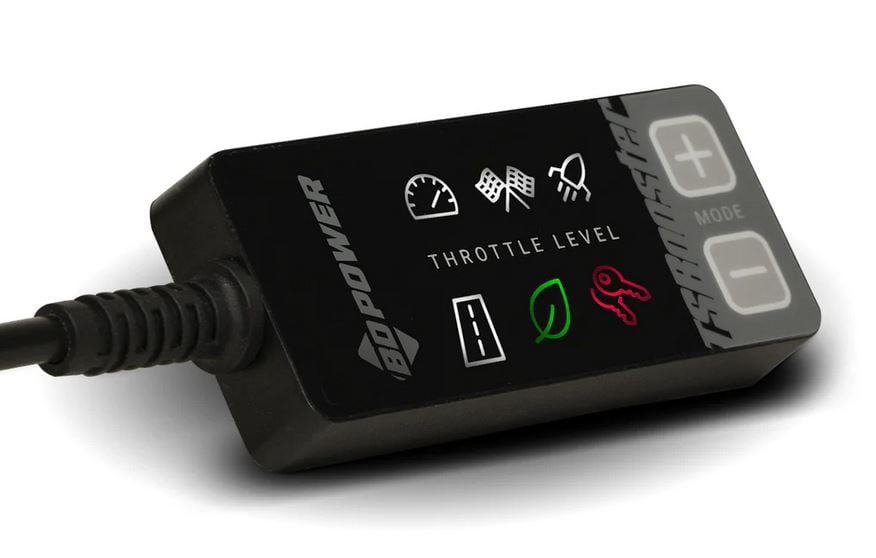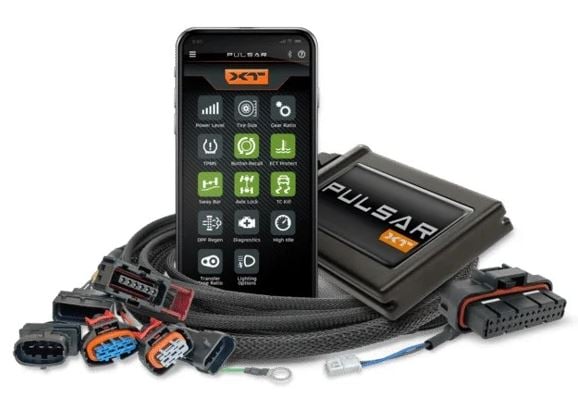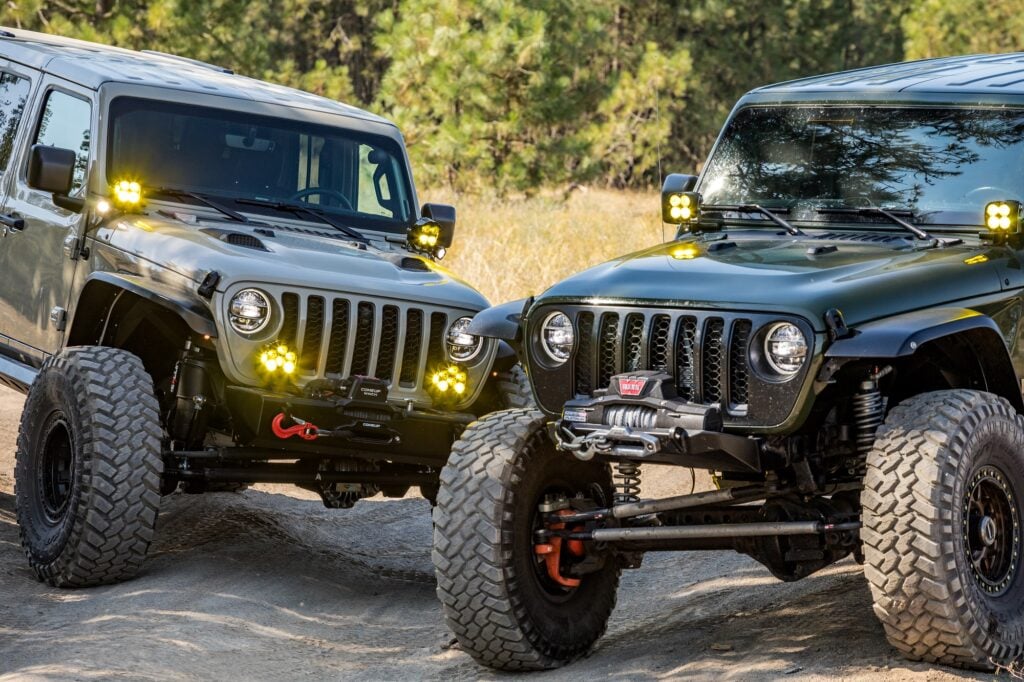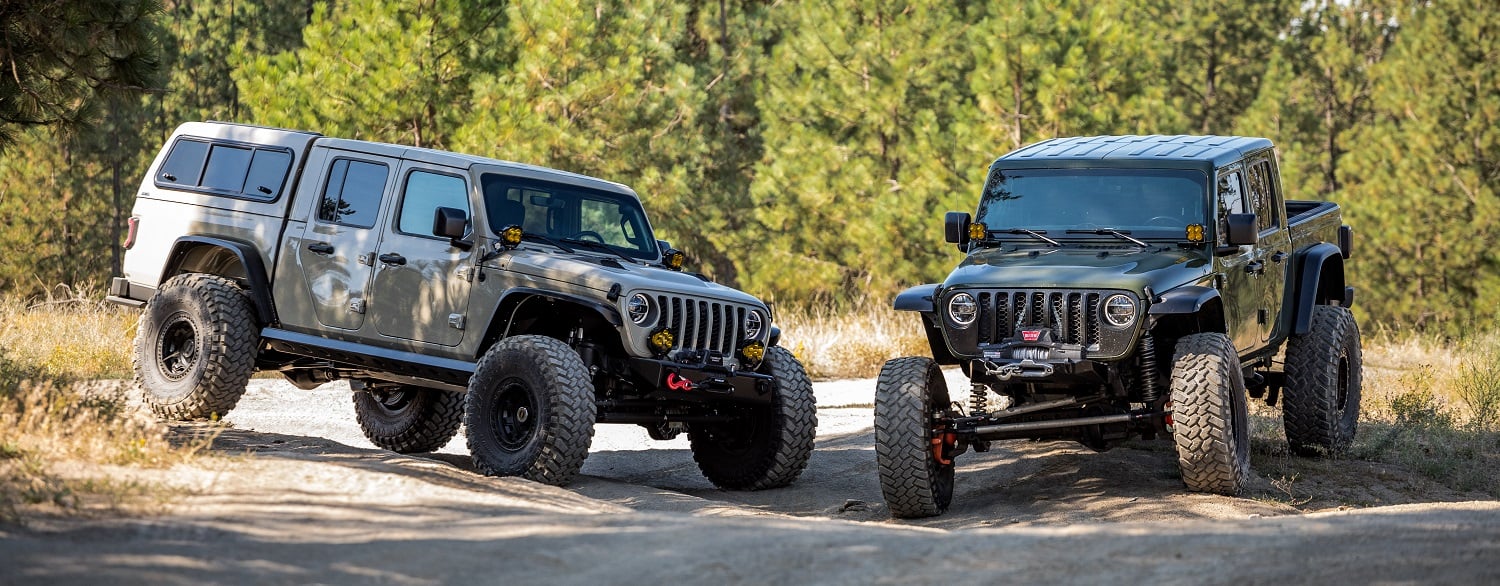After years of begging for a Jeep Wrangler diesel, in 2020, Jeep fans and diesel fans got their wish. New for the 2020 model year, FCA released the JL Wrangler available with the 3.0L turbo diesel, aka the EcoDiesel. The EcoDiesel Jeep of our dreams had arrived, and a year later the diesel Gladiator arrived on the market as well. The new diesel-powered Jeep was touted as having more power, more MPG and better towing capabilities. While the EcoDiesel provides 25 less horsepower than the largest gas engine available prior to the 392, the 3.6L Pentastar V6, it offers 183 more lb-ft of torque which more than makes up for the loss in horsepower. Combine that with its 8-speed transmission and the engine is always within its power band, taking advantage of all the good the EcoDiesel has to offer. All that low RPM diesel torque means owners can, among other things, forego gear swaps when upgrading to moderately larger tires, something that was always a must with the gas versions. The addition of 37” tires makes an almost unnoticeable difference in acceleration. But also, and maybe the most important for long off-road trips: EcoDiesel Jeeps get significantly longer range—up to 80-miles more versus the 3.6L petrol engine (depending on the driver of course) which is significant especially for those of us that do long hauls on or offroad with our rigs.
Jeep EcoDiesel
Hard facts: The 3rd Generation 3.0L EcoDiesel, manufactured by Italian company VM Motori, is a dual overhead cam design, 24-valve V6 featuring a Bosch injection system with Piezo injectors and a CP4 high pressure fuel pump capable of 29,000 psi (Yes; that’s the same pump that’s currently under recall–more on that in a bit). The engine utilizes a single variable geometry turbocharger (VGT for short). Block is constructed from compacted graphite iron, just like the new 6.7L Cummins, while the heads are a heat-treated hardened aluminum alloy. On the emissions side the EcoDiesel is equipped with a dual loop EGR system, catalyst as well as a diesel particulate filter. Together this results in 260 horsepower and 442 lb-ft of torque.
Jeep 3.0 Diesel
The emissions system seems to have all the bugs worked out as we’re not seeing too many failures. And as far as other common issues, those also seem to be fairly low in regards to the amount of vehicles affected vs produced. Power is plenty for off roading, the turbo does lag a little on road but once you’re used to the application of power, it’s a non-issue. That being said, a throttle sensitivity booster like BD’S V3.0 makes this lag much less noticeable.

Sadly, in January of 2023 Jeep and Ram, more correctly Stellantis, stopped production of the EcoDiesel engine. Right after they got all the bugs fixed, too. So, the last year you can get a brand new off the showroom floor EcoDiesel Jeep is 2023. Hurry up and go scoop one up!
Jeep Wrangler Diesel: What We Love
Overall, the EcoDiesel option in the Wrangler JL is a great powerplant. While the 392 model that’s been out since 2021 has more power, it fails in regards to mileage and with the torque the EcoDiesel has, it’s not too shy of a high-performance vehicle on its own. All said and done, in terms of power, mileage and reliability, we couldn’t ask for more. In our own testing we found that the mileage is closer to 26 MPG in stock form on the highway as opposed to the 29 MPG as rated by the factory. That’s no surprise as it’s fairly rare for OEM numbers to perfectly match real world numbers, the driver’s right foot also plays a huge role here. With a 4” lift and 37s the highway mileage dropped to 22 MPG, with around 20 MPG in the city. That is still great mileage for a rig on 37-inch muds.
Jeep Wrangler Diesel Problems
First and second generation EcoDiesel’s had a myriad of issues. From the EGR coolers failing, to electrical issues, oil cooler issues, exhaust leaks, camshaft failures and more. However, the 3rd generation EcoDiesel, which is the engine available in the Wrangler JL and Gladiator JT, carries over very few of the former issues. This generation EcoDiesel is eons more reliable than its predecessors, but it does still have some issues so let’s dive in.
CP4 High Pressure Fuel Pump – The elephant in the room. This pump is currently under recall by Stellantis, Jeep’s parent company. This recall looks to encompass roughly 60,000 units. Ask your dealer if yours is covered here. The reason for the failure? Well, the CP4 was designed for use in the European market. On the other side of the ‘Pond’ they use different formulas of diesel than we do here. Long story short, US-grade diesel lacks the lubricity to keep these pumps happy and therefor CP4’s running on US-grade diesel tend to fail. Using a quality additive like F-Bomb can help keep these pumps alive.
EGR Cooler – While there doesn’t seem to be many issues with the 3rd gen EcoDiesel’s EGR system, we have heard of some failures so it’s worth mentioning here. When they fail, they can do many things, the biggest being contaminating the oil with coolant. When this happens, the bearings aren’t lubricated properly and end up failing. The fix? A whole new engine. Often that means a new block too. Preventative maintenance involves using a quality upgraded cooler from companies like Bullet Proof Diesel. These coolers have been proven to significantly outperform stock coolers and they’re 50-state legal too.
Overheating – Also an issue that we rarely hear of, when it does come up its usually during high stress situations like climbing an 8% grade in 100+ degree weather, while towing. The thought is that there’s not enough areas in the front end of the Jeep for heat to escape. Looking at the 2024 redesign of the front end would help validate this assumption. What many have done is swap out the hood for one with ventilation like a Rubicon or 392 hoods have. It’s such an intermittent problem, we can’t say if this fixes it or not, but the science behind a ventilated hood makes perfect sense.
Electronic Throttle Controller issues – Every common issue comes from a CEL and message on the gauge cluster that states “Service Electronic Throttle Control.” When it happens, often randomly, the engine generally goes into limp mode, limiting power severely. It’s an easy fix to get back on the road, simply shut the engine off and start it again. What’s scary is if it happens during a situation like passing a semi. Getting out of the way of a 100,000lb truck with no power can be very dangerous. While many would disagree that this is the cause, Jeep says the issue is caused by touching the throttle and brake pedals simultaneously. It’s a very common issue that tends to happen on average every 5-10k miles early on in the vehicle’s life, generally going away and never coming back after there’s about 30k miles or so on the odometer.
Dash lights flicker followed by Limp Mode or No Start – A fairly uncommon occurrence. While driving the dash will light up like a Christmas tree, or go completely dark, and the vehicle goes into limp or worse, shuts off altogether. The issue is a wiring harness under the vehicle rubbing on the exhaust. Once it wears through, you’ve got all sorts of electrical problems. The location of this harness is on the passenger side just above the DPF. Look for one of the exhaust connections for the EGR, and you’ll see a harness resting on it. Assuming the harness hasn’t worn through already, you can tie it out of the way and/or wrap it to protect it and this won’t be an issue in the future.
Loose Fuses – Many owners have had random electrical issues that went away after noticing and fixing a few loose relays and fuses under the hood. From the factory it appears that not all fuses and relays were seated fully. Enough to pass inspection, but after some miles the connections become less than ideal. The fix? Simply push down on every fuse and relay to make sure they’re seated properly. Easy as that. Every JL/JT owner should do this as a preventative measure, not just EcoDiesel owners.
Shop Aftermarket Diesel Jeep Parts at DPP!

As always, early on there wasn’t too much out there in terms of performance upgrades specific to the EcoDiesel Jeep JL and Gladiator. But now that we’ve got a few years of production on the platform the aftermarket options are strong. Companies like Banks Power and Edge Products make performance modules each with their own specific features. The Banks’ Derringer system is nice because it offers the Banks IQ for monitoring as well as tune adjustments. Edge’s Pulsar system is also nice but a little different, allowing engine monitoring from your phone or via their CTS3, and tune adjustments via the cruise control buttons on your steering wheel. The Edge Pulsar system also allows you to do things like canceling the auto shutoff feature and more, a feature only available from them (unless you add outside modules like the JL TAZER). For the most part each system offers the same power gains, but both apply the power differently so what you’ll enjoy most depends on your driving style. Banks’ Derringer tends to rev a little higher relying on horsepower, while the Edge Pulsar system feels like it makes more power down low in the RPM range. If you’re not looking for horsepower gains, there’s also several throttle sensitivity boosters from BD Diesel, Banks and Edge that will get rid of the accelerator delay that exists from the factory on most newer vehicles, including the EcoDiesel Jeep. Those make huge differences to drivability.
It doesn’t end with tuning. S&B Filters makes a very nice intake system for the diesel JL and JT that is available in both an oiled, reusable filter as well as a dry, disposable filter. Intake upgrades can also be had from AFE Power in multiple styles including a simple drop-in filter replacement. Moving onto the exhaust side of things MBRP makes full DPF back kits for the JL and JT, with more options for the JT from AFE. Some of those kits not only offer an improvement in exhaust tune, but offer better clearance off road with the removal of the factory muffler. AFE Power also makes some upgraded intercooler piping for the JL that offers a little better flow in and out of the intercooler.




We bought a 22 rubicon wrangler diesel. We love it! It is the best jeep I have ever owned (I’ve owned 7). My first new vehicle was a 91 Comanche! All my kids learned to drive in a 96’ Cherokee manual
We’d have to agree that the Ecodiesel powered Wrangler / Gladiators are awesome. I’ve lost count but I think there’s four or five of them in our parking lot right now!
I am all about diesel engines so I knew that once my back was tired of my YJ, I was going to order a new 2022 Wrangler EcoDiesel. The torque is SUPER impressive for only 3.0 liters. I am bummed that it doesn’t sound or smell like a diesel as I love both, but I’ll live with that.
I was really surprised that Jeep decided to drop the diesel as an option, as it made the most sense as the best engine for off roading.
My eco diesel failed at 155k miles. High pressure fuel pump failed, jeep has been in shop for months now,alot of stuff has failed now need a new intake I ended up trading the jeep in. Not worth the hassel
I wish I could say this was the first instance I’ve heard of a failed HPFP and a Jeep sitting at a dealer’s lot waiting for the repairs and parts. The reports of issues exactly like this are unlimited, and for no good reason. The HPFP on these EcoDiesels have an abnormally high failure rate, but they can be retrofitted with a more available and more dependable CP4.2 or CP3 with some adapter fittings and a reprogram of the ECM. Long ago, we retrofitted a Ram 1500 with the EcoDiesel engine merely for additional power output and the changeover was no more difficult than that. We’ve gone to every aftermarket fueling manufacturer to try and convince them to release a conversion kit for the Jeeps, but no one has dove into it still, which is disheartening because it really is a great platform, but it has a detrimental flaw….the HPFP.
I have a 2021 Jeep Wrangler JL Rubicon with the diesel engine. It’s now been in the shop for about 6 months. Electronic Throttle Control and LIMP MODE. Unlike some of the forums I’ve read, restarting it does not make the limp mode go away. it has 34000 miles. I’m currently trying to claim lemon law because we haven’t had use of it for half a year so far. Any advice would be welcomed.